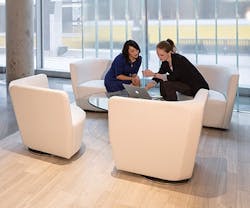Outfitting Offices for Wellness
By now, many of us know how to talk the talk about advocating for wellness in the workplace, but how many of us walk the walk? When architecture firm HKS moved to their new location in downtown Dallas, bringing a focus of wellness to their urban office was a no-brainer.
The 140,000-square-foot office space on North Saint Paul Street occupies six floors that are connected by a central staircase to dissuade elevator use, and features plenty of natural sunlight and outdoor terraces.
But the building’s shell was just the beginning. Offering fresh fruit, mid-afternoon yoga classes, and financial advisor meetings, HKS aimed to embody a holistic approach to health and wellness—and it’s evident in every piece of carpet, furniture, and bulletin board. We sat down with Olga Acosta, the company’s associate principal and senior interiors project manager, to discuss how and why wellness became such a residing factor in their office space.
interiors + sources: Why was wellness such an important factor for your Dallas office?
Olga Acosta: It’s partially a generational thing, but it’s also the overall healthcare system and the impact it has on employees and employers. There are just so many things an employer can truly impact, and one of those is the office environment.
We are one of those firms that promotes people coming into the office rather than work from home because we’re heavily team-oriented, and if we’re encouraging you to come to the office, we need to create an environment that is desirable, and doesn’t impact you in any negative way. So it was important from the very beginning for us to identify how the next 75 years of our existence was going to be monumental, and how we could create that perfect environment—or as close to that as possible, because I don’t know if there’s such a thing. But what is it that we could do to attract the best of the best from around the world and retain them once we got them here?
i+s: What were some of your main concerns in sourcing wellness products?
OA: We did a lot of research and one of the biggest things that we were after was to be as minimally invasive about how we approach design, and we wanted to come out of this with LEED Platinum because as a firm we made a commitment to be responsible stewards of natural resources.
An architect and design group has a responsibility to do research, to really understand not only the products themselves and their quality, longevity, and performance, but also where they originated and how they were manufactured. We met with a lot of manufacturers, we reviewed them, and they told us their story. Then we back-checked how they actually produce their products, and how they are tested. What are the results of those tests? Are they certified? What do those certifications mean? It really came down to avoiding bringing as many toxic chemicals as possible into the office. That’s how we chose.
i+s: What has been the biggest hit?
OA: I don’t know that it’s one thing. I really truly believe it’s a collective thing. My needs and those drivers for me are different from my neighbors. As we were planning this relocation, one of the things we talked about a lot was how we energize our space. How do we keep things from getting stagnant? We are about creating spaces, and creativity comes to us in different shapes and sizes.
i+s: How has making wellness a priority affected your office space?
OA: Hands down, it’s been a positive impact. People are happier. You can’t plan for every scenario, but you can respond to it, and I think that’s the thing that makes for very positive impact. I see and hear that people aren’t talking about being in a dark corner of the building, people aren’t talking about the indoor air quality here as opposed to the old warehouse space we were in before. People aren’t talking about allergens.
They’re talking about the real challenges of our career, stuff that we come in and get paid for. In reality, you shouldn’t have to worry when you go to work. You shouldn’t have to worry about whether or not you are going to react negatively to the products that are in that space. If it’s done right, people don’t even think about it. They just show up to work. They’re worried about the other things they should be worried about.
